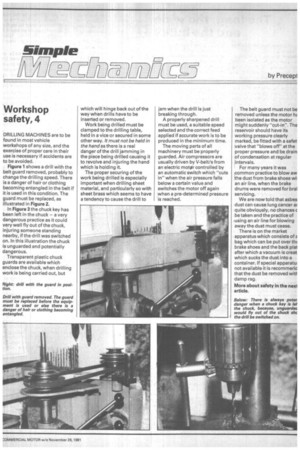Workshop safety, 4
Page 31

If you've noticed an error in this article please click here to report it so we can fix it.
DRILLING MACHINES are to be found in most vehicle workshops of any size, and the exercise of proper care in their use is necessary if accidents are to be avoided.
Figure 1 shows a drill with the belt guard removed, probably to change the drilling speed. There is a danger of hair or clothing becoming entangled in the belt if it is used in this condition. The guard must be replaced, as illustrated in Figure 2.
In Figure 3 the chuck key has been left in the chuck — a very dangerous practice as it could very well fly out of the chuck, injuring someone standing nearby, if the drill was switched on. In this illustration the chuck is unguarded and potentially dangerous.
Transparent plastic chuck guards are available which enclose the chuck, when drilling work is being carried out, but which will hinge back out of the way when drills have to be inserted or removed.
Work being drilled must be clamped to the drilling table, held in a vice or secured in some other way. it must not be held in the hand as there is a real danger of the drill jamming in the piece being drilled causing it to revolve and injuring the hand which is holding it.
The proper securing of the work being drilled is especially important when drilling sheet material, and particularly so with sheet brass which seems to have a tendency to cause the drill to jam when the drill is just breaking through.
A properly sharpened drill must be used, a suitable speed selected and the correct feed applied if accurate work is to be produced in the minimum time.
The moving parts of all machinery must be properly guarded. Air compressors are usually driven by V-belt/s from an electric motrir controlled by an automatic switch which "cuts in" when the air pressure falls below a certain value and switches the motor off again when a pre-determined pressure is reached.
The belt guard must not be removed unless the motor hE been isolated as the motor might suddenly "cut-in". The reservoir should have its working pressure clearly marked, be fitted with a safer valve that "blows off" at the proper pressure and be drain of condensation at regular ,interva Is.
For many years it was common practice to blow aw the dust from brake shoes wi. an air line, when the brake drums were removed for bral servicing.
We are now told that asbes dust can cause lung cancer at quite obviously, no chances c be taken and the practice of .using an air line for blowing away the dust must cease.
There is on the market apparatus which consists of z bag which can be put over tht brake shoes and the back plat after which a vacuum is creat which sucks the dust into a container. If special apparatui not available it is recommend that the dust be removed witt damp rag.
More about safety in the nein article.








































